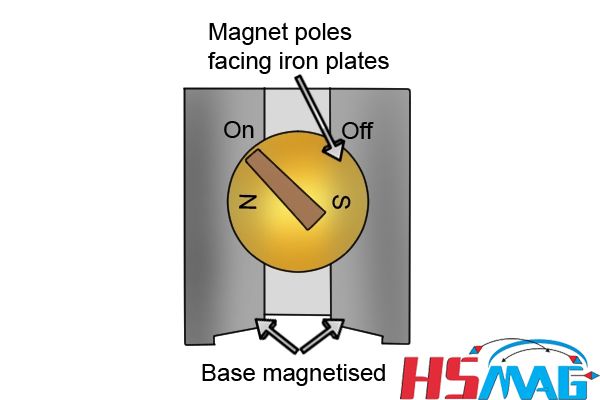I would have thought in the on position. Look at the diagram. When it is off the magnet is not doing anything. So when on the metal it is adhered to becomes the keeper.
Steve.

Steve’s post deserves more attention! This type of magnetic base does not have a keeper, and I believe it’s the most common. Unfortunately, I can’t prove it by taking mine apart – can’t see any screws, and suspect it’s a press-fit assembly. I don’t want to break it.
HSMag’s description appears to be a shortened version of that on wonkydonkeytools, which has more diagrams. This pair I think shows more clearly how moving the magnet magnetises the base, there is no keeper:


The absence of a keeper is counter to what I was taught at school, but in later life I found many examples of lessons that were too simplified, or out-of-date.
Early magnets weren’t made of the best possible materials because they hadn’t been discovered yet, and permanent magnets demagnetised. Their decay was slowed by completing the magnetic circuit with a keeper.
Poor magnetic materials caused a lot of problems, such as failing magnetos, so materials scientists have been looking for improvements for over a 150 years. Very successfully, first with a basic AlNiCo, then a series of improvements, ending with today’s Rare Earth alloys. Modern materials demagnetise very slowly, so the need for a keeper has diminished, perhaps to vanishing point. However, the need for a keeper is embedded in folk-lore and it’s “not wrong”.
I don’t think there’s a black and white answer. There’s a good reason for putting keepers on ancient magnet bases, and good reasons turning modern bases off, even though that means there’s no keeper. It depends on what the magnet is made of and what the designer allowed for.
Moving on, I can’t find the internet explanation of why Eclipse magnetic gizmos self-destruct when opened. However, if I remember correctly, grinding clamps are carefully engineered to maximise the magnet flux available for clamping. Unfortunately, a side-effect is opening the box causes the magnet to demagnetise itself. In this diagram, imagine the flux shown turning back on itself at the poles being strong enough to permanently wrench billions of atomic N-S alignments inside the magnet sideways, thus weakening it. Rapidly apparently!

I expect the magnet self-destructs when opened by Eclipse, but they have the wherewithal to re-magnetise it. We don’t!
It’s possible Eclipse changed what the magnet is made of. An original AlNiCo magnet would demagnetise, whilst a rare earth substitute might not care.
Dave
john fletcher 1.









